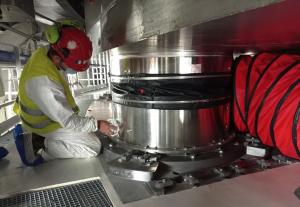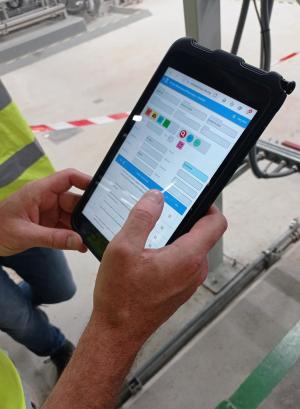The fine art of preservation
To keep components and materials in good condition prior to entering service, a set of actions needs to be performed. These activities, which are specific to a given piece of equipment, are collectively referred to as "preservation activities."
A small central preservation team coordinates the preservation activities and tracks the equipment over the three stages, "We liaise with the responsible parties during each of the stages to make sure the equipment has clearly defined preservation requirements, and a responsible party is assigned to perform the activities," says Richard Brown, Maintenance Management Officer in the Operations Division. "We also make sure the activities are planned and scheduled, and that any issues that are uncovered are recorded and followed up."
Preserving captive components
Preservation is particularly critical for "captive" components that may need preserving for a decade or longer before entering service. A captive component is typically a large item that, once installed, can no longer be easily removed. It is closed in either by a building structure or by other large equipment. Examples of captive equipment are the cryostat support bearings (CSBs) and the four large tanks in the drain tank room.
The 18 bearings, each about the size of a dining room table, are installed in the Tokamak pit. These bearings allow some relative movement in the cryostat to buffer expansion due to temperature changes, or excessive loads that hit the vacuum vessel in the cryostat. The preservation activities include regularly monitoring the air humidity conditions in the Tokamak pit and performing visual checks for signs of grease, moisture or other aggressors.
Tracking all preservation activities
"Some of the activities may seem rather simple," says Brown. "They are nevertheless critical to ensuring the equipment is retained in good condition, and to reducing the risk of problems occurring when the system is commissioned. For example, motors and pumps need to be turned regularly to avoid brinelling (the permanent indentation of a hard surface) of the bearings, valves have to be greased and operated to avoid seizure, and vessels need to be kept inerted (filled with inert gas to keep air from coming in and moisture from developing) to prevent corrosion. The challenge is to keep track of all activities and ensure the responsibility for executing them is clear at all stages."
Over time, preservation will become more challenging. More first-of-a-kind equipment will be installed as assembly and construction progresses. This means that both the volume, but also the complexity of preservation activities, will increase substantially.
"In addition to managing the preservation activities associated with conventional plant equipment, we will also have some preservation requirements that are quite specific to ITER systems," says Brown. "For example, the gyrotrons used in the electron cyclotron heating system must have the quality of the vacuum maintained during long term storage. This means the internal ion pump must remain connected to a high voltage power supply. For cases like this we have to make sure that the correct provisions are in place before the items are received on site."
To stay on top of all activities, the preservation team helped define a process that starts before equipment is delivered on site. Before delivery, the technical responsible officer (TRO) ensures that the preservation requirements are defined and available. Usually, these are based on the original manufacturer's recommendations, but in cases where nothing is prescribed by the manufacturer, the TRO relies on standard guidelines for the type of equipment to write the preservation requirements.
New software provides real-time reporting and information sharing
To help improve the overall implementation of the process, ITER is rolling out a new piece of web-based software called SPMat Mobile Companion, which will allow real-time reporting on preservation activities in the field. The software runs on any tablet or handheld device to allow technicians to record the activities directly.
The new system will also allow TROs to get more up-to-date reports on the preservation activities carried out on their equipment. The software includes a workflow engine that allows people to schedule tasks, define to-do lists and receive alerts to stay on top of activities. The new system provides better traceability and auditability, especially for safety-critical, protection-important components.
"We went live with the new software in May," says Brown. "We are steadily expanding the scope of the equipment managed in the new tool, and we are training users. The new software makes it easier for people in the field to perform preservation activities, and it provides more detailed and up-to date information for equipment owners."




